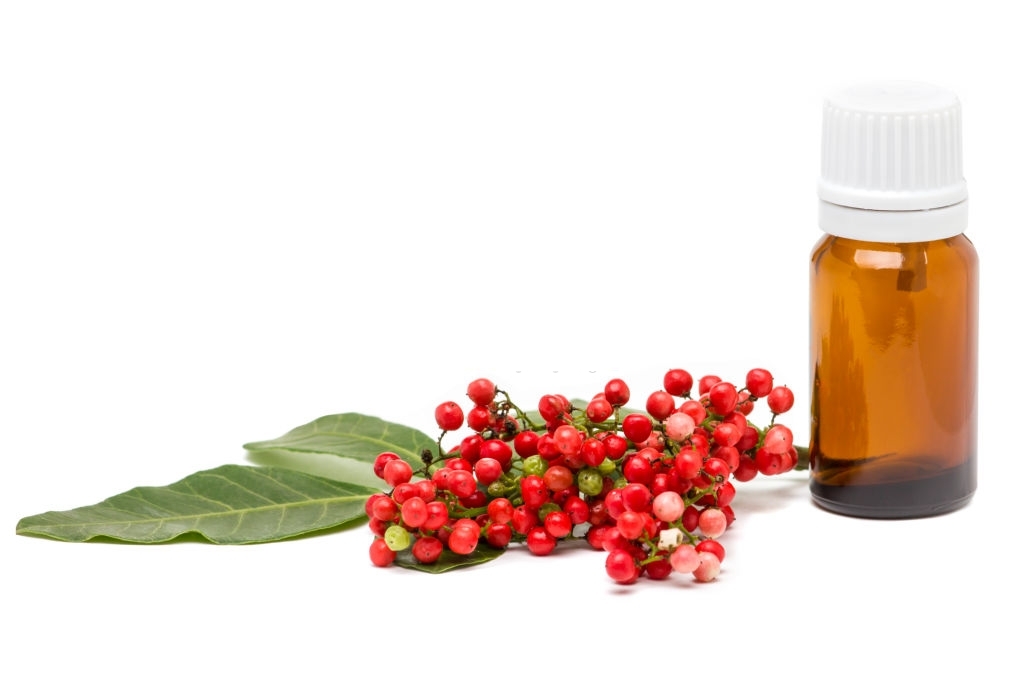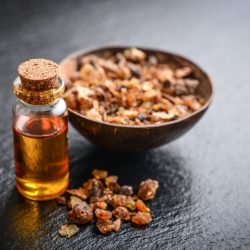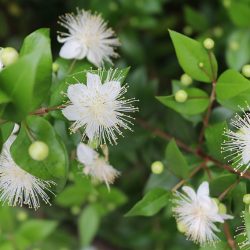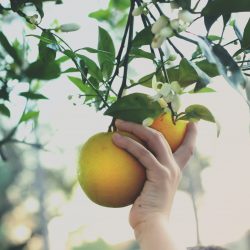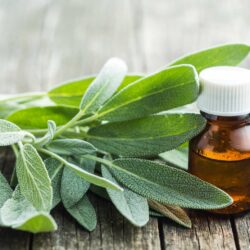Pistachio mastic, botanical name Pistacia lentiscus, belongs to the Anacardiaceae family. Its essential oil is obtained from the leafy branches.
Frankincense is a type of resin with a strong odour derived from the sap of the Pistachio Mastic. In ancient times, this natural resin was used as chewing gum. Today, in Iran, it is still used for this purpose. But the mastic tree could also be found in tablet form, mixed with other plants such as lavender and frankincense, or simply in its raw form, i.e. the resin obtained by cutting into the bark of the mastic tree. The Latin name lentiscus seems to derive from the word lentus, “soft”, given the texture of this resin before it dries in the open air, as is also the case with myrrh, frankincense, etc. This gum has been chewed since ancient times to maintain good oral and dental hygiene and correct gastric acidity.
A little history
Since ancient times, mastic has been widely known around the Mediterranean basin, particularly the resin that sometimes flows naturally from this tree, a mastic secretion in the form of tears , as is the case in Turkey or Greece (on the island of Chios, for example, the mastic secretes mastic in tears) where its incense was once burnt by fumigation as an offering to the gods. In Egypt, there are three types: white, black and red. One of the most famous ancient Egyptian recipes includes mastic among a host of ingredients: kyphi.
Theophrastus, Dioscorides, Pliny, Columella and Scribonius Largus all mentioned this resin, which they called mastixchia. Alexander of Tralles often used this resin, which was also widely used by the great names of Arab medicine, such as Avicenna and Ibn el Baithar. In the Middle Ages, it was also used to treat a variety of ailments, including angina pectoris, lung ailments, palpitations, oedema, haematuria and hepatic colic, not to mention digestive disorders.
At that time, around the year 1000, it was used in many ways, for both internal and external ailments: angina, lung diseases, palpitations, dropsy, haematuria, hepatic colic, stomach problems, wounds, etc. But, more commonly, mastic has been chewed since Antiquity to keep the mouth perfectly clean and to correct gastric acidity. This was still the case on the island of Chios in the 19th century. This is why the mastic tree is a symbol of purity and virginity.
So it’s hardly surprising to find the mastic tree among the attributes ofArtemis and, before her, of a Cretan deity called Britomartis (in other words, “the good virgin”), whomArtemis quickly supplanted, although Greek mythology never forgot her, since she became Artemis’ nymph, known as Dictynna. This also explains why Hellenic virgins adorned themselves with mastic.
Botanical description
The mastic is a shrub growing from 1 to 3 metres in height in the wild, and can reach twice that height when grown as an ornamental in the garden. In both cases, it is a species typical of dry, rocky soils, such as the maquis, and can be found on hillsides and slopes in the south of France, Corsica, Morocco, Greece, Turkey and Bulgaria. The leaves of the mastic are made up of four to ten pairs of dark green, shiny, elongated leaflets that are not toothed and turn a light shade of purple in winter.
The flowers, which are greenish at first, also turn more reddish with age. The fruits, pea-sized, more or less red, sometimes almost blackish, appear in October and November.
In France, the mastic tree is not the only Pistacia species, as there are also the true pistachio tree(Pistacia vera), which produces greedy pistachios, and the terebinth(Pistacia terebinthus) which, unlike the mastic tree, sheds its leaves in the off-season.
What are the pharmacological properties of the essential oil of the leafy branches of the Pistachio Mastic?
The pharmacological properties of Pistachio Mastic essential oil are many and varied. In fact, this essential oil has been used for centuries for its many therapeutic virtues. In this part of the article, we’re going to focus on the pharmacological properties of the leafy branches of the Pistachio Mastic tree, to better understand how this essential oil can help us maintain our health and well-being.
Venolymphatic decongestant properties :
Pistachio Mastic essential oil is considered a leader in venous and lymphatic circulation disorders, and is used both for lymphatic drainage and cellulite, applied locally, and as an anti-oedematous, disinfiltrating and phlebotonic agent.
Antimicrobial properties :
Antibacterial, against Klebsiella pneumoniae and Helicobacter pylori, Pistachio Mastic has also been proven to be an antifungal (by inhibiting biofilm formation in Candida albicans). Theα-pinene it contains is also antibacterial against methicillin-resistant Staphylococcus aureus. This molecule potentiates the antibiotic effect of tetracycline on Staphylococcus aureus by acting on the efflux pumps. It also has activity against Actinomadura madurae, which can cause actinomycetoma.
So α-pinene modulates antibiotic resistance in Campylobacter jejuni, reduces the minimum inhibitory concentration of antibiotics (ciprofloxacin, erythromycin, triclosan), inhibits microbial efflux pumps and alters membrane integrity and microbial metabolism.
Anti-inflammatory properties:
Α-pinene is anti-inflammatory, with adrenergic stimulation and chondroprotective action. Its anti-inflammatory activity is achieved by suppressing MAPK (mitogen-activated protein kinases) and the NF-kB (nuclear factor-kappa B) pathway in peritoneal macrophages.
As for the myrcene contained in pistachio mastic essential oil, it is anti-inflammatory by inhibiting gamma interferon and IL-4 production.
Anti-cancer properties:
Essence of Pistachio Mastic protects cells against certain cancerous cell lines. This can be seen in particular in the inhibition of tumour progression in colon cancer. This is due to the activity of NK cells, which increase their cytotoxicity thanks toα-pinene.
Anti-ulcer properties :
The myrcene contained in pistachio mastic is also a powerful gastric and duodenal anti-ulcer agent. It considerably increases antioxidant enzyme activity, glutathione and defence factors in the gastric mucosa.
Other properties:
- Prostatic decongestant
- Healing
- Antispasmodic
- Analgesic
- Local thermogen
- Sedative and muscle relaxant
How to use Pistachio Mastic essential oil?
| Condition | How to use Pistachio Mastic Essential Oil | Efficacy | Application details |
|---|---|---|---|
| Heavy legs | Simple use | For children aged 6 and over. Rub 1 drop of Pistachio Mastic in 9 drops of vegetable oil into the skin and massage into the legs from the bottom upwards, morning and evening, for 20 days, followed by a one-week break. | |
| Use in Synergy | Reserved for children aged 6 and over. Massage from the ankles up the legs with 4 to 6 drops of the mixture, 3 times a day: 30 drops of Juniper essential oil, 30 drops of Mastic Pistachio, 15 drops of Patchouli, 15 drops of Peppermint, 75 drops of Calophylla Inophylla vegetable oil. | ||
| Prostatitis | Easy to use | Suitable for adults. Applied to the skin, 1 drop of Pistachio Mastic in 4 drops of vegetable oil, massage into the lower abdomen and back 2 to 3 times a day for up to 3 weeks. | |
| Use in Synergy | Suitable for adults. Take 3 drops of the mixture on a lump of cane sugar or in a spoonful of olive oil 3 times a day for 15 days: 2 drops of Patchouli, 1 drop of Pistachio Mastic, 3 drops of Sweet Geranium, 2 drops of Cypress de Provence, 2 drops of Rose Geranium. | ||
| Phlebitis | Simple use | For children aged 6 and over. Applied to the skin, 1 drop of Pistachio Mastic in 4 drops of vegetable oil, massage into the legs from the bottom upwards, morning and evening, for 20 days, followed by a one-week break. Pay attention to the nature of the phlebitis. | |
| Pistachio mastic or Italian Helichrysum? | In the event of phlebitis, use Italian Helichrysum for its circulatory action, applied diluted to the skin. | ||
| Oedema | Simple use | Reserved for children aged 6 and over. Applied to the skin, 1 drop of Pistachio Mastic in 4 drops of vegetable oil, massage into the affected area 2 to 3 times a day for a maximum of 3 weeks. | |
| Use in synergy | For adults and adolescents only. Apply locally to the oedema 3 times a day for 5 days: 2 drops of Patchouli, 1 drop of Pistachio Mastic, 1 drop of Peppermint, 2 drops of True Lavender, 2 drops of Italian Helichrysum. |
Does Pistachio Mastic essential oil require any precautions for use?
- Not recommended for children under 12 years of age
- Do not diffuse (traces of ketones)
- Do not inhale when damp
- Caution in cases of renal failure per os (nephrotoxic)
- Do not combine with cortisone, risk of drug interaction
- Cytochrome P450 inhibitor, risk of drug interactions, ask your pharmacist for advice
- Not recommended for asthmatics
- Not recommended for animals
- Contraindicated in pregnant or breast-feeding women
- May cause skin irritation (dermocaustic) when used undiluted, dilution required
Medical literature and clinical trials:
- Prokopios Magiatis, Eleni Melliou, Alexios-Leandros Skaltsounis, Ioanna B. Chinou, Sofia Mitaku. Chemical Composition and Antimicrobial Activity of the Essential Oils of Pistacia lentiscus var. chia. Planta Med 1999
- Magiatis P, Melliou E, Skaltsounis AL, Chinou IB, Mitaku S. Chemical composition and antimicrobial activity of the essential oils of Pistacia lentiscus var. chia. Planta Med. 1999
- Duru ME, Car A, Kordali S, Zengin H, Harmandar M, Izumi S, Hirata T. Chemical composition and antifungal properties of essential oils of three Pistacia species. Fitoterapia. 2003
- Spyridopoulou K, Tiptiri-Kourpeti A, Lampri E, Fitsiou E, Vasileiadis S, Vamvakias M, Bardouki H, Goussia A, Malamou-Mitsi V, Panayiotidis MI, Galanis A, Pappa A, Chlichlia K. Dietary mastic oil extracted from Pistacia lentiscus var. chia suppresses tumor growth in experimental colon cancer models. Sci Rep. 2017
- Rivas da Silva AC, Lopes PM, Barros de Azevedo MM, Costa DC, Alviano CS, Alviano DS. Biological activities of α-pinene and β-pinene enantiomers. Molecules. 2012
- Freitas PR, de Araújo ACJ, Barbosa CR, Muniz DF, Tintino SR, Ribeiro-Filho J, Siqueira Júnior JP, Filho JMB, de Sousa GR, Coutinho HDM. Inhibition of Efflux Pumps by Monoterpene (α-pinene) and Impact on Staphylococcus aureus Resistance to Tetracycline and Erythromycin. Curr Drug Metab. 2021
- Stojković D, Soković Marina, Glamočlija Jasmina, Džamić Ana, Ristić M., Fahal A., Khalid Sami, Đuić Ivana, Petrović Silvana. Susceptibility of three clinical isolates of Actinomodura madurae to α-pinene, the bioactive agent of Pinus pinaster turpentine oil. Archives of Biological Sciences 2008
- Kovač J, Šimunović K, Wu Z, Klančnik A, Bu car F, Zhang Q, Možina SS. Antibiotic resistance modulation and modes of action of (-)-alpha-pinene in Campylobacter jejuni. PLoS One. 2015
- Astani A, Reichling J, Schnitzler P. Comparative study on the antiviral activity of selected monoterpenes derived from essential oils. Phytother Res. 2010
- Xia Z, Mao X, Luo Y. [Study on antifungal mechanism of alpha-pinene] Hunan yi ke da xue xue bao = Hunan Yike Daxue Xuebao = Bulletin of Hunan Medical University. 1999
- Martin S, Padilla E, Ocete MA, Galvez J, Jimenez J, Zarzuelo A. Anti-inflammatory activity of the essential oil of Bupleurum fruticescens. Planta Med. 1993
- Rufino AT, Ribeiro M, Judas F, Salgueiro L, Lopes MC, Cavaleiro C, Mendes AF. Anti-inflammatory and chondroprotective activity of ( )-α-pinene: structural and enantiomeric selectivity. J Nat Prod. 2014
- Jo H, Cha B, Kim H, Brito S, Kwak BM, Kim ST, Bin BH, Lee MG. α-Pinene Enhances the Anticancer Activity of Natural Killer Cells via ERK/AKT Pathway. Int J Mol Sci. 2021
- Rufino AT, Ribeiro M, Sousa C, Judas F, Salgueiro L, Cavaleiro C, Mendes AF. Evaluation of the anti-inflammatory, anti-catabolic and pro-anabolic effects of E-car yophyllene, myrcene and limonene in a cell model of osteoarthritis. Eur J Pharmacol. 2015
- Baudoux, D. L’aromathérapie: se soigner par les huiles essentielles.

